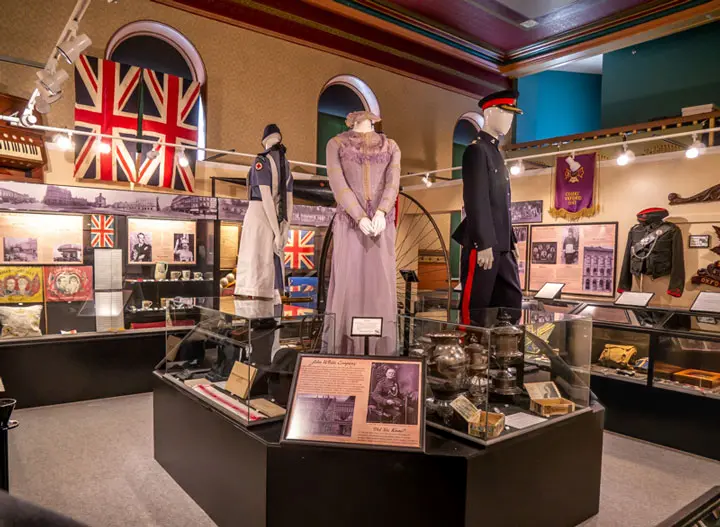Visualize, Customize, Optimize, with Argus
An Argus Success StoryThe Woodstock Museum National Historic Site Challenges
- Configurability, expandability
- Single venue for all databases
- SaaS (Canada-based)
- Mobile capabilities
- Integration between databases with bilateral linkages
- Predictable cost
Curator of Collection
WOODSTOCK MUSEUM NHS
Housed in Woodstock’s Old Town Hall, built in 1853, the Museum collection consists of 25,000 artifacts, including 13,000 photographs, and 3,500 archival objects such as posters, magazines, catalogs, and letters. Curator Adam Pollard is a solo practitioner who manages the Argus CMS and all the museum exhibits, sometimes with the assistance of a summer associate.
Challenges and Vision
Originally, the museum collection was documented and managed via a database which was expressed through the museum’s own website. There came a point when the City of Woodstock decided to pull all the different city departments into their IT structure and onto the City’s website—and the museum’s database was incompatible with this strategy. As a result, they acquired their first collections management system (CMS) but struggled with its limitations when it came to making modifications, uploading data, and customizing the user interface.
A few years on, the City of Woodstock briefly experienced security issues which affected all departments, and cut off access to the museum’s database for several months. Per Mr. Pollard, “This really highlighted the need for a CMS managed and hosted by another entity, partly because IT resources were very stretched in a city of 40,000 people.”

Enter Argus
Having seen Argus and been impressed by a demonstration of its powerful capabilities at the Ontario Museum Association’s Annual Conference, Mr. Pollard conducted his vendor due diligence. He spoke with 3 or 4 very happy references, and in addition, looked into Lucidea itself. He was very comfortable with the company’s many years of experience and positive reputation across the product portfolio, and saw its international presence as a strong indicator of solid security and firewalls. For the City of Woodstock, pursuing a SaaS (software-as-a-Service) solution dictated that data be housed in Canada; Lucidea met this critical requirement—and the City’s IT leaders were very impressed and satisfied with Lucidea’s rock-solid server and hosting security parameters.
During the implementation, Mr. Pollard worked very closely with Lucidea’s Client Services team, and found that “in addition to knowing the software, the museum subject matter expertise within that team was very helpful. They were really on top of what I wanted and great in terms of figuring out how to make it happen.” As a result of working so closely with CS, he now knows how to do all his own uploading and is comfortable with adding to the system’s structure when required.

Useful, Expandable
Although Argus is very powerful right “out of the box”, if your preference is to customize and optimize for your organization, you can change the way things look, change how data is presented, create tables to import data, and start linking to other resources. Says Mr. Pollard, “It’s such a useful product; that’s really the thing that separates it from other CMS platforms. Because I can see and manipulate the database I can make it much more efficient to enter data. I can hide fields I don’t want. Basically, I can tailor it to exactly how I want it; therefore, the workflow is incredibly efficient. Another valuable aspect of Argus is its expandability. You can add much more data than the average CMS can accommodate. For us, the ability to add many databases is key.”
Integrated and Optimized
The Woodstock collection within Argus consists of 5 databases now linked together. These include Military Records, Business Directors, the Heritage Property Database, a City Councillors database, and the core collection database. With these differing collections linked within Argus, it’s possible to pull an artifact, for example, and see what business(es) it’s related to, confirm years in business, and aggregate all that data. Bilateral searching enables researchers to specify a city councillor, and then see what artifacts are related to that person—or the other way around.
The Woodstock Museum’s Heritage Committee managed a database of heritage properties that is now within the Museum’s instance of Argus. They’re delighted to be able to cross-reference the heritage properties with items in the core collection, for a holistic view. Their previous database was an “all-in-one-record” system, but within Argus the data can be easily split. As an example, per Mr. Pollard, “You have a property, and you can link it to multiple buildings on the same property. If one building was lost in a fire and rebuilt, you can see the relevant sub-records. Argus gives you the ability to see your data in new ways, because you have the tools to easily manipulate it.” Heritage Committee members are so happy with what Argus enables that they want Mr. Pollard to make a presentation to the City Council, which is sure to spur even greater interest in the system.
Forward-Thinking
Mr. Pollard’s plans for expansion of Argus’ impact include leveraging its mobile capabilities; he has spent significant time tailoring the mobile experience to give cellphone users a nice display and optimal functionality. Within the Museum, he would like to integrate Argus into the artifact intake process and eliminate paper-based forms used for donation. His vision is to have donors fill out their information via an iPad for direct entry into Argus.
Working with the system continues to generate new ideas; viewing the Museum’s large photographic collection within Argus (including uploading one image and choosing the preferred resolution when displaying it in multiple places) has been great in terms of pulling exhibits together. And Mr. Pollard envisions—together with the Museum’s Communication and Education staff—using Argus as part of an expanded social media strategy to further increase the Museum’s visibility.
In closing, Mr. Pollard told us that Argus allows him to work “proactively and progressively”; for today’s museums, it’s essential to keep up with (and apply) technology that enables museum professionals to visualize, customize, and optimize access to collections and services. For the Woodstock Museum NHS, Argus more than meets that challenge.